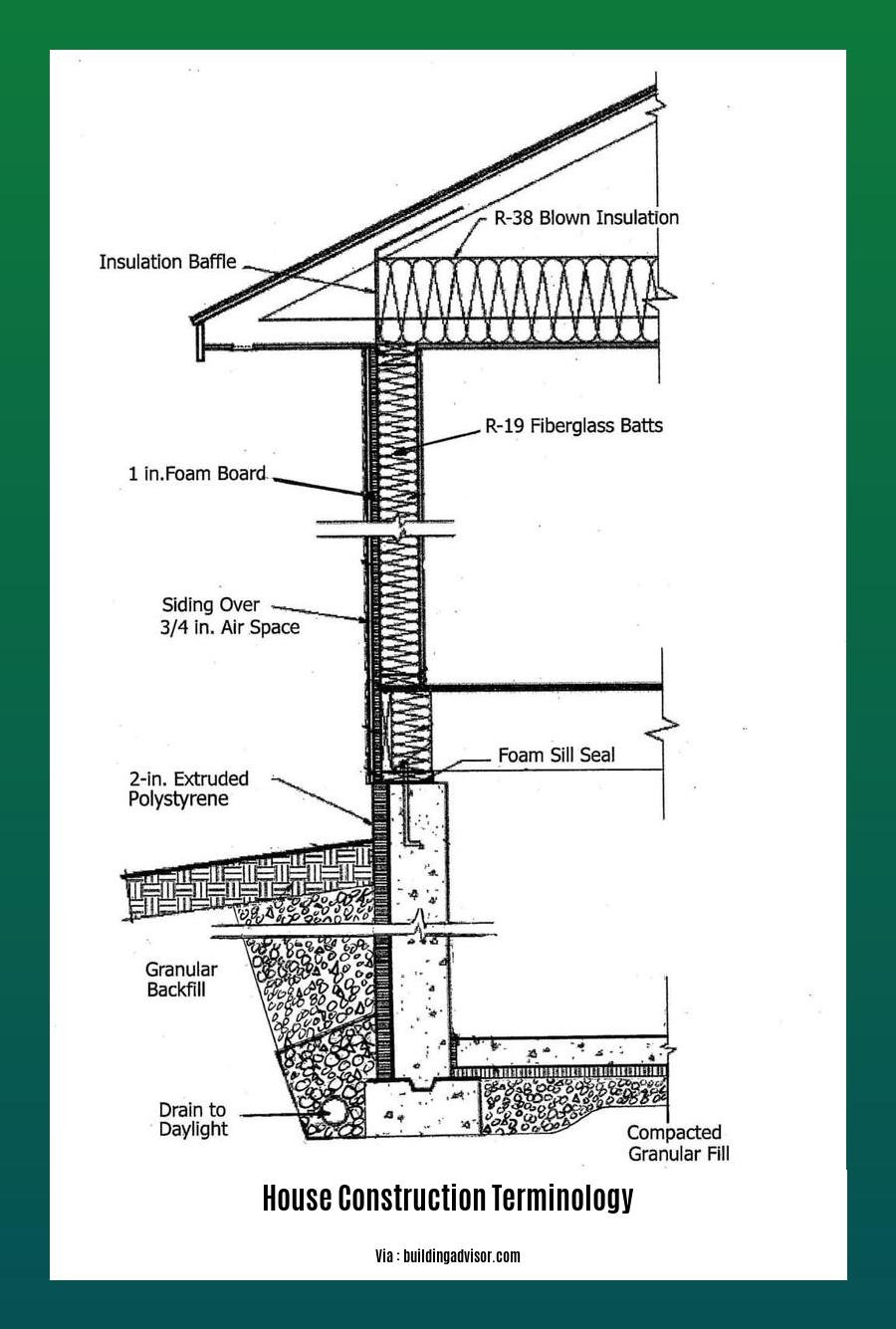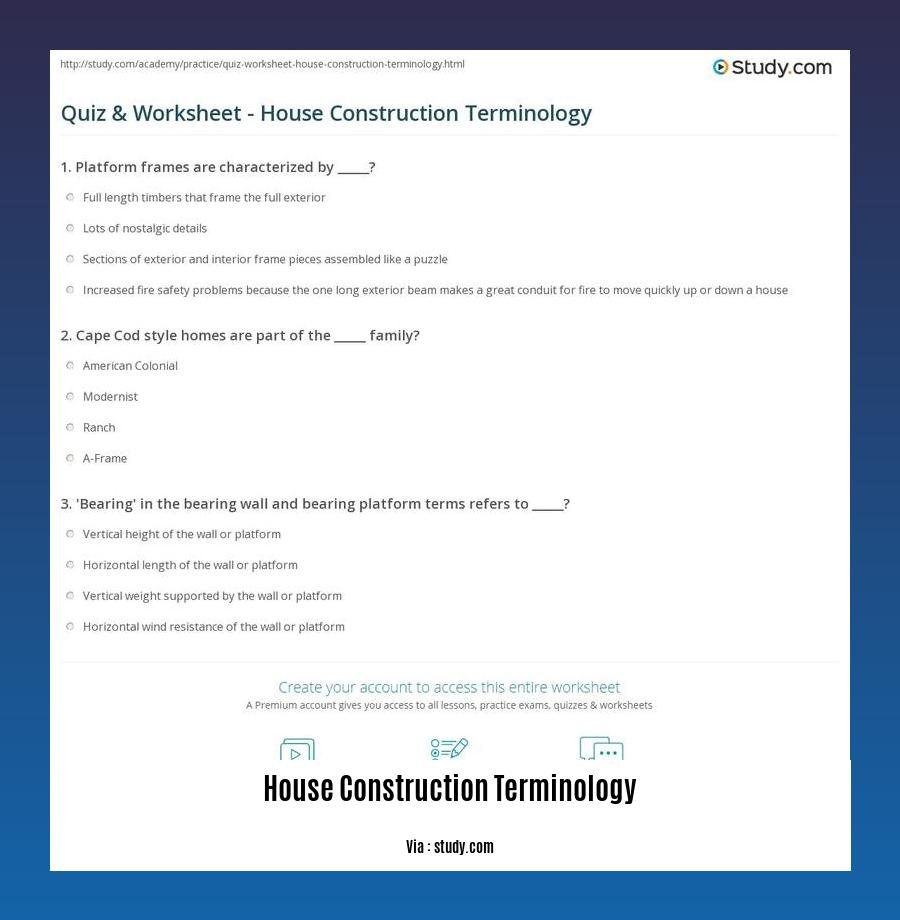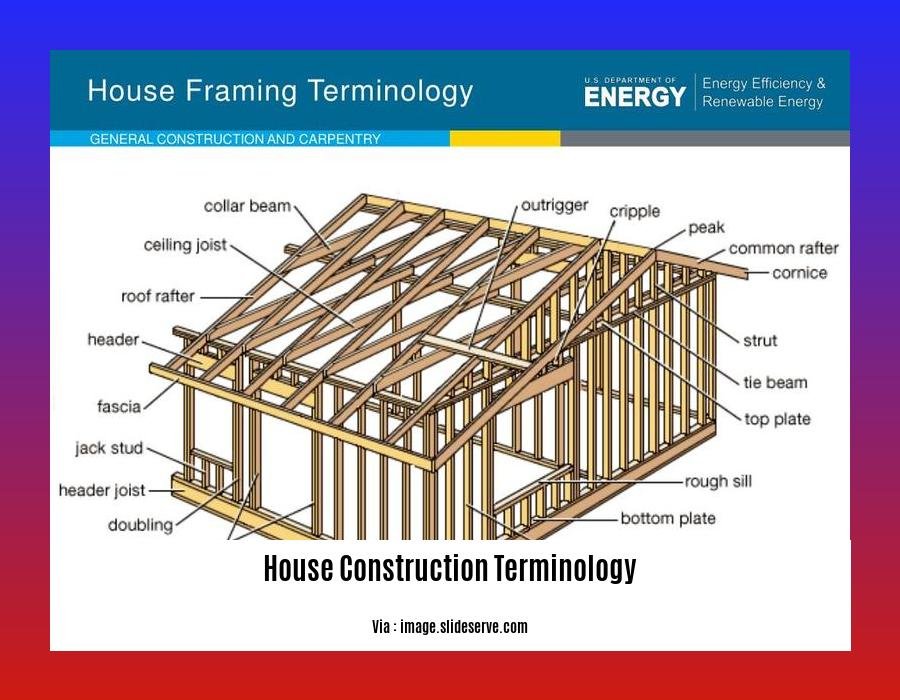Dive into the intricate world of house construction with our comprehensive guide, “Understanding House Construction Terminology: A Comprehensive Guide.” Whether you’re an aspiring homeowner, a seasoned contractor, or simply curious about the intricacies of building a home, this guide will equip you with the knowledge to navigate the complex language and jargon used in this field.
Key Takeaways:
-
Measurement Terms: Area refers to the measurement of space in square units.
-
Construction Stages: Backfilling involves filling a dug hole with soil or other material.
-
Design and Planning Documents:
- Blueprints provide detailed drawings of a construction project.
- Building information modeling (BIM) uses 3D digital models for planning building details.
- Architectural drawings are technical renderings of the final house design.
- Elevations are drawings that show the vertical layout of a building.
House Construction Terminology

In the realm of house construction, understanding the language spoken by architects, engineers, contractors, and homeowners is crucial. This comprehensive guide will break down key house construction terminology to help you navigate the intricacies of this field like a pro.
Measurement Terms
- Area: Measure of space in square feet or meters.
Construction Stages
- Backfilling: Filling in excavated areas with soil or other materials.
Design and Planning Documents
- Blueprint: Detailed drawing outlining a construction project.
- Building information modeling (BIM): 3D digital representation of building details.
- Architectural drawing: Technical illustration of a building’s design.
- Elevations: Vertical cross-sections of a building.
Construction Process Terms
- Framing: Creating the skeleton of a building.
- Plumbing: Installing pipes and fixtures for water and drainage systems.
- Electrical: Wiring and installing electrical outlets, switches, and appliances.
- HVAC: Designing and installing heating, ventilation, and air conditioning systems.
- Insulation: Adding materials to reduce heat loss or gain.
Design Terms
- Facade: Exterior of a building.
- Floor plan: Overhead view of a building’s layout.
- Roofing: Materials and techniques used to cover a building’s roof.
- Windows: Openings in walls to allow light and ventilation.
- Doors: Passages for entry and exit.
Safety Terms
- OSHA: Occupational Safety and Health Administration, responsible for workplace safety.
- PPE: Personal protective equipment, such as hard hats, gloves, and safety glasses.
- Risk assessment: Evaluating potential hazards and devising plans to mitigate them.
Other Important Terminology
- Estimate: Projected cost of a construction project.
- Contract: Agreement between the owner and contractor outlining project details.
- Warranty: Guarantee or promise regarding workmanship or materials.
Remember, understanding house construction terminology empowers you to effectively communicate with professionals and make informed decisions throughout your construction journey. Embrace this knowledge to elevate your understanding and navigate the world of house construction confidently.
Explore our house construction material calculator to estimate the quantity of materials required for your dream home.
Calculate the cost of materials for your construction project with ease using our comprehensive house construction material cost calculator.
Refer to our house construction specification sheet for detailed guidelines on the materials and specifications to ensure a sturdy and aesthetically pleasing structure.
Discover the step-by-step process of building a house in Kerala through our informative guide on house construction steps in kerala.
Understanding Safety Procedures on a Construction Site

Safety is paramount on any construction site. Understanding Safety Procedures on a Construction Site is crucial for preventing accidents, injuries, and fatalities. Here’s how to prioritize safety on your site:
Key Takeaways:
- Prioritize maintaining a safe work environment.
- Enforce the use of Personal Protective Equipment (PPE).
- Implement high-quality training to educate workers on safety protocols.
- Communicate safety guidelines effectively.
4 Pillars of Safety on a Construction Site:
1. Safety Precautions:
- Enforce the use of PPE, including hard hats, safety glasses, and gloves.
- Establish clear rules and regulations for working at heights and with dangerous equipment.
- Provide regular safety training to all workers, including subcontractors.
- Regularly inspect the site for potential hazards and address them promptly.
2. Safety Plan:
- Develop a comprehensive safety plan that outlines all safety procedures and protocols.
- Regularly update the safety plan to reflect changes in protocols or personnel.
- Communicate the safety plan to all workers and ensure they understand their responsibilities.
3. Hazard Mitigation:
- Identify and assess potential hazards, such as falls, electrical hazards, and equipment malfunctions.
- Implement measures to prevent or minimize hazards, such as proper equipment usage, fall protection, and hazardous material handling procedures.
- Monitor the site for changing conditions that may introduce new hazards.
4. Emergency Preparedness:
- Establish emergency response procedures and communication systems.
- Conduct regular drills to prepare for emergencies, such as fires, accidents, and natural disasters.
- Equip the site with necessary safety gear, such as fire extinguishers, first-aid kits, and emergency communication devices.
Citation:
[BigRentz: Construction Site Safety 101: A Complete Guide [2024]]
Project Management in Home Construction
Navigating the complexities of Project Management in Home Construction requires familiarity with the industry’s key terms. Here’s a comprehensive guide to help you understand these terms:
Key Takeaways:
- Agile Project Management prioritizes adaptability and flexibility.
- Backlog refers to a list of pending tasks or projects.
- A Bill of Quantities (BOQ) lists all materials, equipment, and labor for a project.
- The Construction Manager oversees project planning, coordination, and supervision.
- The General Contractor is responsible for managing the entire project, including hiring subcontractors and budget.
- A Meeting Agenda outlines topics to be discussed during meetings.
- Meeting Minutes document discussions and decisions made in meetings.
- The Project Architect designs the construction project.
- The Project Engineer handles the technical aspects of the project.
- A Project Schedule outlines project milestones and deadlines.
- A Punch List identifies incomplete or defective tasks before project completion.
- The Scope of Work defines each party’s roles and responsibilities.
- Subcontractors perform specific tasks hired by the general contractor.
Benefits of Effective Project Management
- Project Success: Proper planning and coordination ensure timely, on-budget project execution.
- Cost Efficiency: Effective project management minimizes overruns and reduces waste.
- Reduced Risk: Identifying and mitigating potential issues proactively reduces project risks.
- Enhanced Communication: Clear communication channels ensure effective collaboration among team members.
Challenges in Project Management
- Unforeseen Events: Weather, material delays, or labor shortages can impact project progress.
- Budget Constraints: Managing funds effectively without compromising project quality can be challenging.
- Change Orders: Scope changes or design revisions can affect project timelines and costs.
- Communication Barriers: Miscommunication or lack of coordination can lead to project delays.
Best Practices for Successful Project Management
- Plan Meticulously: Outline project scope, schedule, budget, and risk management strategies.
- Communicate Effectively: Establish clear communication channels and keep stakeholders informed.
- Monitor Regularly: Track project progress, identify potential issues, and take corrective actions.
- Manage Risk: Anticipate potential problems and implement mitigation plans.
- Document Thoroughly: Maintain comprehensive documentation of project decisions, changes, and progress.
By embracing these key terms and best practices, you can effectively navigate the complexities of Project Management in Home Construction, ensuring successful project outcomes.
Citation:
- Construction Management Terms: A Comprehensive Glossary
Professional Communication and Jargon in the Industry
The construction industry is replete with jargon and technical terms that can be daunting to outsiders and even experienced professionals. To bridge this communication gap, let’s explore some key terms and their significance.
Understanding Construction Terminology
Understanding construction terminology is crucial for effective communication and project success. Terms like “abutment,” “aggregate,” and “anchor bolt” may seem alien initially, but they play vital roles in the structural integrity and functionality of a building.
Importance of Professional Communication
Clear and accurate communication is paramount in construction projects. When different stakeholders – architects, engineers, contractors, and homeowners – use consistent terminology, it minimizes misunderstandings, delays, and costly errors. Adopting industry-standard terms ensures all parties are on the same page.
Key Takeaways:
- Understanding construction terminology is essential for effective communication.
- Professional communication using industry-standard terms streamlines projects.
- Jargon and technical terms may vary, but a shared understanding is crucial.
Citation:
- Construction Placements. (2018, October 12). 151 Most Common Construction Terms.
FAQ
Q1: What are the basic measurement terms used in house construction?
A1: Measurement terms typically refer to the area, which is measured in square units like square feet or square meters. It indicates the amount of space a particular area covers.
Q2: What is a blueprint in the context of construction?
A2: A blueprint is a detailed technical drawing that serves as a plan for a construction project, outlining the exact specifications and measurements for the building’s construction.
Q3: What is the significance of a safety plan at construction sites?
A3: A safety plan is crucial, as it outlines all the safety procedures and protocols that must be followed on a construction site. It helps prevent accidents and ensures the well-being of workers and visitors.
Q4: What is the difference between a general contractor and a subcontractor?
A4: A general contractor is responsible for overseeing the entire construction project, including hiring subcontractors, while a subcontractor specializes in a specific task or set of tasks within the project, such as electrical work or plumbing.
Q5: What is the purpose of a punch list in house construction?
A5: A punch list is a document that lists any outstanding tasks or defects that need to be completed or fixed before a construction project is considered complete and ready for handover.
- The Best Battery Picture Lamps for Effortless Artwork Illumination - April 1, 2025
- Double Sink Bath Vanity Tops: A Buyer’s Guide - April 1, 2025
- Bath Towel Measurements: A Complete Guide to Choosing the Right Size - April 1, 2025










